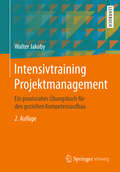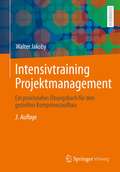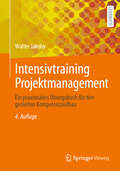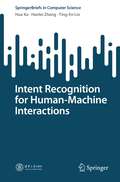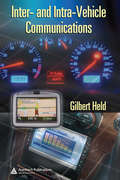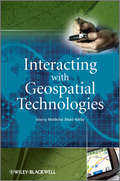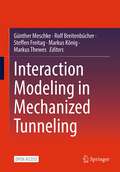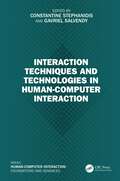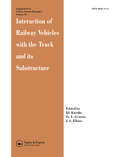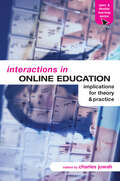- Table View
- List View
Intensivtraining Projektmanagement: Ein praxisnahes Übungsbuch für den gezielten Kompetenzaufbau
by Walter JakobyIn diesem Übungsbuch werden die Kenntnisse des Projektmanagements kompakt zusammengefasst und durch Verständnisfragen überprüft. Die Anwendung wird mit Hilfe praxisnaher Übungsaufgaben und kommentierter Lösungen intensiv trainiert, so dass sich das Buch als unmittelbare Vorbereitung auf Klausuren und Prüfungen eignet.Im abschließenden Praxisprojekt werden alle Methoden an einem durchgängigen Beispiel angewendet. Es kann als anschauliches Vorgehensmuster für das Planen und Steuern eigener Projekte verwendet werden und ermöglicht so einen nahtlosen Übergang vom Aufbau der Kompetenzen zu deren praxisgerechter Nutzung.
Intensivtraining Projektmanagement: Ein praxisnahes Übungsbuch für den gezielten Kompetenzaufbau
by Walter JakobyIn diesem Übungsbuch werden die Kenntnisse des Projektmanagements zunächst kompakt zusammengefasst. Mit Hilfe von Verständnisfragen kann der Wissensstand dann überprüft und durch praxisnahe Übungsaufgaben mit kommentierten Lösungen vertieft werden, so dass sich das Buch als unmittelbare Vorbereitung auf Klausuren und Prüfungen eignet.In einem umfangreichen Praxisprojekt werden die erworbenen Kompetenzen anschließend zur Lösung der Aufgaben des gesamten PM-Lebenszyklus angewendet. Dies bildet ein anschauliches Vorgehensmuster für das Planen und Steuern von Projekten und ermöglicht so einen nahtlosen Übergang zu eigenen realen Projekten.
Intensivtraining Projektmanagement: Ein praxisnahes Übungsbuch für den gezielten Kompetenzaufbau
by Walter JakobyIn diesem Übungsbuch werden die Kenntnisse des Projektmanagements zunächst kompakt zusammengefasst. Mit Hilfe von Verständnisfragen kann der Wissensstand dann überprüft und durch praxisnahe Übungsaufgaben mit kommentierten Lösungen vertieft werden, so dass sich das Buch als unmittelbare Vorbereitung auf Klausuren und Prüfungen eignet.In einem umfangreichen Praxisprojekt werden die erworbenen Kompetenzen anschließend zur Lösung der Aufgaben des gesamten PM-Lebenszyklus angewendet. Dies bildet ein anschauliches Vorgehensmuster für das Planen und Steuern von Projekten und ermöglicht so einen nahtlosen Übergang zu eigenen realen Projekten.
Intent Recognition for Human-Machine Interactions (SpringerBriefs in Computer Science)
by Hua Xu Hanlei Zhang Ting-En LinNatural interaction is one of the hottest research issues in human-computer interaction. At present, there is an urgent need for intelligent devices (service robots, virtual humans, etc.) to be able to understand intentions in an interactive dialogue. Focusing on human-computer understanding based on deep learning methods, the book systematically introduces readers to intention recognition, unknown intention detection, and new intention discovery in human-computer dialogue. This book is the first to present interactive dialogue intention analysis in the context of natural interaction. In addition to helping readers master the key technologies and concepts of human-machine dialogue intention analysis and catch up on the latest advances, it includes valuable references for further research.
Intentional Stance Towards Humanoid Robots: Lessons Learned from Studies in Human-Robot Interaction
by Agnieszka WykowskaWith the reinassance of Artificial Intelligence (AI) and AI-empowered technologies, such as robots, we are all asking ourselves the question: What role will these new technologies play in our lives and in our society? On the one hand, we are excited about the new opportunities that AI and robots bring. On the other hand, there are understandable fears: What if the AI becomes too powerful? What if the robots become too human-like? This book is centered around a theoretical framework of the Intentional Stance, initially proposed by Daniel Dennett, and addresses the timely question: How do we, humans, approach robots? Do we see them as intentional agents that can potentially become our social companions? Or do we rather approach them as tools, man-made artifacts? What does it take for a robot to make an impression that it is an intentional/social agent? Is it its appearance? Its behaviour? Or, perhaps (and quite likely), the way it interacts with the human? These questions are addressed across various chapters of book, each of which is then complemented by an inspiring conversation with one of the prominent academics and scholars: Daniel Dennett (Philosophy) – the originator of the concept of the Intentional Stance; Hiroshi Ishiguro (Robotics) – the creator of androids, David Gunkel (Robot-Ethics), Bertram Malle (Cognitive Science), Antonio Sgorbissa (Culturally-competent Social Robotics), Bill Vorn (Robotic Art). The book discusses also some important ethical considerations to be made, and risks to be aware of. Do we actually want to create robots that are treated as intentional agents? What if the line between the human/robot categories becomes blurred? As intentional agents, should robots become also moral agents and legal persons in our societal and legal systems?
Intentional and Inherent Nonlinearities in Piezoelectric Energy Harvesting (SpringerBriefs in Applied Sciences and Technology)
by Michele RossoThis book presents recent research in the field of piezoelectric vibration energy harvesting in which intentionally designed nonlinearities as well as inherently present are widely considered. It provides an overview of the state-of-the-art, with a sharp classification into linear and nonlinear devices, and recalls the fundamentals of piezoelectricity and magnetostatics. A detailed treatment of linear and nonlinear mathematical modeling of piezoelectric harvesters is then developed to provide the reader with a wide range of modeling possibilities. Theoretical, computational, and experimental approaches to modeling the magnetic interaction are also provided. Several cases of innovative piezoelectric harvester designs based on magnetic interaction as a frequency up-conversion mechanism (FuC) are developed. Improvements of the magnetic FuC are proposed, in combination with indirect impacts as well as the manipulation of magnetic forces with novelty methods. Novel studies on the magnetic interaction itself and its implications for the dynamic behavior of the harvester are also summarized. The book provides an integrated view of theoretical, computational, and experimental research in this field, as such it can be useful for researchers interested in linear and nonlinear piezoelectric energy harvesting, for graduate courses on smart structures and devices, microsystems, and for designers.
Inter- and Intra-Vehicle Communications
by Gilbert HeldThe PC revolution, the advent of PDAs, and growth in the use of wireless LANs have changed the way we live our lives. Next on the horizon is the application of new technologies that will change the way we drive our cars. De rigeur for many drivers, electronic passes and GPS systems represent the tip of the iceberg in terms of emerging applications
Inter-Laboratory Study on Electrochemical Methods for the Characterization of Cocrmo Biomedical Alloys in Simulated Body Fluids
by A. Igual MunozThis special issue of Corrosion Engineering Science and Technology is dedicated to the study of corrosion of objects from historical sites. The issue contains contributions from the 2009 EUROCORR session on Corrosion of Archaeological and Heritage Artefacts organised by the European Federation of Corrosion's working party and commissioned articles on other key issues. The objective is to give the reader a broad understanding of corrosion of ancient materials, for the most part metal but also glass. Articles shed light on a range of analytical approaches related to the study of the complex systems that make up historical artifacts. In order to arrive at an understanding of the nanometric organisation of rust layers and interphases, such studies must be approached on a macroscopic scale. Techniques used include; macrophotography, synchrotron radiation and transmission electron microscopy (TEM) that ensure results that are both exhaustive and representative of particular observations. This issue demonstrates the wealth of approaches possible in the study of the corrosion of ancient materials.
Inter-Organizational Relationships
by Cecilia Rossignoli Francesca RicciardiThis book explores the premise that organizations are significantly influenced by their inter-organizational relationships; moreover, these relationships may generate important externalities, both positive and negative, impacting the environment at several levels. The advent of the Internet era, on the other hand, has resulted in disruptive changes in traditional inter-organizational networks, and some completely new inter-organizational settings are now arising. In its first part the book reviews the most commonly cited theories explaining inter-organizational phenomena: transaction costs economics, agency theory, resource dependence theory, game theories, collaborative networks theory, institutional theories, organizational ecology, resource-based / relational-based view of the firm, and knowledge network / social network theories. In Part II it thoroughly reviews the literature on a number of key IT-enabled inter-organizational systems currently on the rise, such as virtual organizations, e-intermediators and e-marketplaces. Lastly, Part III presents the case of the Yoox Group, a leading firm offering e-commerce services for fashion and design products. A framework is proposed for systematically linking the different possible types of inter-organizational relationships to specific, suitable sets of theories. The range of possible inter-organizational relationships is described on the basis of three pairs of opposites: conformism-breach, exploitation-exploration, and cooperation-competition. This results in a model that makes it possible to combine different theories in order to study the effects of inter-organizational ambidexterity and dynamism on performance.
Inter-area Oscillations in Power Systems
by Arturo Roman MessinaThis book deals with the application of new techniques based on time-frequency system representations and statistical approaches to the study, characterization, and control of nonlinear and non-stationary inter-area oscillations in power systems. The main focus is on the study of nonlinear, time-varying wide-area oscillatory problems associated with critical system perturbations. Techniques that explicitly address and treat nonlinearity are given and efficient methods to generate time-varying system approximations from both measured and simulated data are discussed. The theoretical basis for these methods is described as well as application properties and performance. Analysis techniques discussed include parametric methods such as Prony analysis, Yule-Walker based methods, Least-Squares methods, Wavelets and Fourier-based methods, and non-parametric methods such as Periodogram averaging and the Hilbert-Huang transform, as well as higher order statistical approaches. Emphasis is placed on the modeling and control of complex time-varying behavior which has not been present in previous work. Through case studies of synthetic and real-life test systems, the authors explain how an understanding of temporal, nonlinear behavior can be incorporated in the analysis and design process of complex control systems. Examples include computer simulations and actual system measurements from power systems in North America, Australia, India and Mexico. Particular attention is given to the vital new ideas of dynamic security assessment in real-time implementations and the evaluation of spatio-temporal behavior in systems with embedded f Flexible ac Transmission Systems (FACTS). Future applications of these methodologies focusing on the implementation of smart wide-area monitoring, protection control systems based on methods of analysis of time series are also discussed.
Interacting Boson Model from Energy Density Functionals
by Kosuke NomuraThis thesis describes a novel and robust way of deriving a Hamiltonian of the interacting boson model based on microscopic nuclear energy density functional theory. Based on the fact that the multi-nucleon induced surface deformation of finite nucleus can be simulated by effective boson degrees of freedom, observables in the intrinsic frame, obtained from self-consistent mean-field method with a microscopic energy density functional, are mapped onto the boson analog. Thereby, the excitation spectra and the transition rates for the relevant collective states having good symmetry quantum numbers are calculated by the subsequent diagonalization of the mapped boson Hamiltonian. Because the density functional approach gives an accurate global description of nuclear bulk properties, the interacting boson model is derived for various situations of nuclear shape phenomena, including those of the exotic nuclei investigated at rare-isotope beam facilities around the world. This work provides, for the first time, crucial pieces of information about how the interacting boson model is justified and derived from nucleon degrees of freedom in a comprehensive manner.
Interacting Processes in Soil Science
by B.A. Stewart Philippe Baveye R.J. WagenetInteracting Processes in Soil Science focuses on coupled processes in soil. Topics covered in this important volume include the effects of inorganic salts upon water flow, modeling of sorption, transport and transformation of organic solutes, and the effects of microorganisms on silicate clay minerals. The book presents studies and approaches that can be extended and complemented by innovative work in the future.Interacting Processes in Soil Science will be an essential reference for all researchers and students in soil science, soil and water engineering, civil and environmental engineering, earth sciences, and hydrology.
Interacting with Geospatial Technologies
by Mordechai Muki HaklayThis book provides an introduction to HCI and usability aspects of Geographical Information Systems and Science. Its aim is to introduce the principles of Human-Computer Interaction (HCI); to discuss the special usability aspects of GIS which designers and developers need to take into account when developing such systems; and to offer a set of tried and tested frameworks, matrices and techniques that can be used within GIS projects. Geographical Information Systems and other applications of computerised mapping have gained popularity in recent years. Today, computer-based maps are common on the World Wide Web, mobile phones, satellite navigation systems and in various desktop computing packages. The more sophisticated packages that allow the manipulation and analysis of geographical information are used in location decisions of new businesses, for public service delivery for planning decisions by local and central government. Many more applications exist and some estimate the number of people across the world that are using GIS in their daily work at several millions. However, many applications of GIS are hard to learn and to master. This is understandable, as until quite recently, the main focus of software vendors in the area of GIS was on the delivery of basic functionality and development of methods to present and manipulate geographical information using the available computing resources. As a result, little attention was paid to usability aspects of GIS. This is evident in many public and private systems where the terminology, conceptual design and structure are all centred around the engineering of GIS and not on the needs and concepts that are familiar to the user. This book covers a range of topics from the cognitive models of geographical representation, to interface design. It will provide the reader with frameworks and techniques that can be used and description of case studies in which these techniques have been used for computer mapping application.
Interaction Between Soil Foundation and Subway Shield Tunnel
by Zhen-Dong CuiThis book addresses the interaction between the soil foundation and the subway shield tunnels under the vibration loading, including the dynamic response of the track inside the shield tunnel, the dynamic properties of soil around the subway shield tunnel, the mechanical properties of subway tunnel, and the long-term settlement of the subway tunnel. Given its scope, it offers a valuable reference guide for designers and construction researchers alike, as well as senior undergraduates and graduate students at colleges and universities.
Interaction Modeling in Mechanized Tunneling
by Markus Thewes Markus König Günther Meschke Rolf Breitenbücher Steffen FreitagThis open access book compiles the research results of the Collaborative Research Center SFB 837, which has been running since 2010 and will end in 2022, with the topic "Interaction Modeling in Mechanized Tunneling". The Collaborative Research Center is funded by the German Research Foundation (DFG) and is currently the world's largest research facility in the field of tunneling. The aim of the publication is to make our scientific findings accessible to the international professional community. The individual chapters deal with all subsystems relevant in mechanized tunneling and their interaction. The latest results of digital planning and real-time tunneling support have been included.
Interaction Techniques and Technologies in Human-Computer Interaction
by Gavriel Salvendy Constantine StephanidisThis book offers a thorough exploration of interaction design by examining various technologies,interaction techniques, styles, and devices.This book• Assists readers in acquiring a deep understanding of diverse ways humans interact withcomputer technologies and in selecting the most suitable approach for various interactivescenarios.• Introduces cutting‑edge interaction techniques, including multimodal and gesture‑basedinteraction, wearables, haptic, speech and sound‑based interaction, embodied interaction,and more.• Advances beyond traditional interfaces to large and multiscreen interactions, proxemics,brain‑computer interfaces, affective computing and Extended Reality.This book will appeal to individuals interested in Human-Computer Interaction research andapplications.
Interaction and Fate of Pharmaceuticals in Soil-Crop Systems: The Impact of Reclaimed Wastewater (The Handbook of Environmental Chemistry #103)
by Damià Barceló Sandra Pérez Solsona Nicola Montemurro Serge ChironThis book provides a comprehensive overview of the current knowledge on the fate and interaction of pharmaceuticals in soil-crop systems. It addresses the principles of their transport, uptake and metabolism and reviews methodologies for their analytical determination. It also discusses ecotoxicological effects arising from their presence and highlights bioremediation approaches for their removal. The use of treated wastewater to irrigate crops is becoming more widespread in regions where freshwater is limited. This practice conserves freshwater resources and contributes to nutrient recycling. However, concerns remain regarding the safety of irrigation with treated wastewater since it contains residues of pharmaceuticals that have survived treatment, which means that soil and fauna are potentially exposed to these xenobiotics. Various pathways govern the fate of pharmaceuticals in crop-soil systems, including soil degradation; formation of non-extractable residues; uptake by soil-dwelling organisms (e.g. earthworms); and uptake, transport, and metabolism in agricultural crops. Investigations into these aspects have only recently been initiated, and there is still a long way to go before a meaningful assessment of the impact of wastewater has been completed.
Interaction of Nanomaterials With Living Cells
by Faheem Arjamend Sheikh Shafquat Majeed Mushtaq A. BeighThis book examines the interactions of nanomaterials with the biological system. The chapters of the book explore the natural and synthetic biomaterials that modulate immune responses for their applications in drug delivery and tissue engineering. Further, the book discusses the implications of the physiochemical properties of nanoparticles and their microenvironment on their interactions with biological systems. The chapters also present the recognitive capabilities of biomaterials for the development of novel strategies for the detection and treatment of autoimmune disorders. The book also introduces nanotechnology platforms for drug delivery and highlights current and emerging nanotechnologies that could enable novel classes of therapeutics. Towards the end, the book reviews the efficiency of drug-loaded nanoparticles in modulating the functioning of the biological milieu for improved disease treatment. Lastly, the book outlines the ethical issues regarding the use of nanoparticles for in vitro and in vivo applications. Given its scope, it is a valuable resource for graduate students and researchers interested in understanding the biomedical applications of nanoparticles and their interactions with the biological milieu.
Interaction of Nanomaterials with the Immune System (Molecular and Integrative Toxicology)
by Jared M. Brown James C. BonnerThis book covers the latest information related to understanding immune responses to engineered nanomaterials (ENMs). Many ENMs used in both the consumer and biomedical fields have been reported to elicit adverse immune responses ranging from innate immune responses such as complement activation to changes in adaptive immunity that influence pathogen responses and promote disease states such as asthma. Interaction of Nanomaterials with the Immune System covers the most up to date information on our understanding of immune responses to ENMs across a wide range of topics including innate immunity, allergic immune responses, adaptive provides the reader with (1) up to date understanding of immune responses to ENMs; (2) current testing methods; and (3) appropriate models including alternative testing strategies for evaluating immunotoxicity of ENMs.
Interaction of Railway Vehicles with the Track and Its Substructure
by Kl. Knothe St. L. Grassie J. A. ElkinsFirst published in 1995. CRC Press is an imprint of Taylor & Francis.
Interaction of Ultrashort Electromagnetic Pulses with Matter
by Valeriy AstapenkoThe book is devoted to the theory describing the interaction of ultra-short electromagnetic pulses (USP) with matter, including both classical and quantum cases. This theme is a hot topic in modern physics because of the great achievements in generating USP. Special attention is given to the peculiarities of UPS-matter interaction. One of the important items of this book is the derivation and applications of a new formula which describes the total photo-process probability under the action of USP in the framework of perturbation theory. Strong field-matter interaction is also considered with the use of the Bloch formalism in a two-level approximation for UPS with variable characteristics.
Interactions Between Agroecosystems and Rural Communities (Advances in Agroecology)
by Cornelia FloraThere is an increasing realization among biophysical scientists that human behavior drastically impacts the degree to which sound agroecosystems are implemented. Written by an international team of experts assembled by a leading rural sociologist, Interactions Between Agroecosystems and Rural Communities shows how human behavior impacts agroecosyst
Interactions Between Electromagnetic Field and Moving Conducting Strip (Lecture Notes in Electrical Engineering #1111)
by Artur Zaporozhets Yuriy Vasetsky Ihor KondratenkoThe book combines two interrelated lines of research. One of them is devoted to the development of the theory for solving a certain class of three-dimensional electromagnetic field problems of the three-dimensional electromagnetic field, taking into account eddy currents in a moving conducting magnetizing body. Preference is given to the development of the analytical solution methods of the three-dimensional quasi-stationary problem of field conjugation in the system: “a contour of an arbitrary spatial configuration with an alternating current is conducting body with a flat boundary surface”. The second direction refers to the development of mathematical models for solving applied problems, which involve the use of developed methods for calculating the electromagnetic field and their characteristics. The main application of calculation methods is aimed at solving problems of heat treatment non-ferrous and ferrous metal products using the induction method of heating in a transverse magnetic field. The inverse problems are solved to determine the inductor configuration as flat and spatial current contours for providing the necessary temperature distribution of moving metal strips. To achieve uniform heating of strips across the width using inductors in the form of flat current contours parallel to the strip surface, it is advisable to use combinations of current contours, where the geometric dimensions are determined by the size and electro-physical parameters of the metal strips. A more uniform temperature distribution during high-frequency induction heating is achieved by using inductors in the form of current contours of the required spatial configuration.The book is intended for researchers, postgraduate students, and students specialized in theory and calculations of electromagnetic fields and induction heating installations.
Interactions in Online Education: Implications for Theory and Practice (Open and Flexible Learning Series)
by Charles JuwahInteractivity is at the very heart of learning and is evident at all levels of engagement, whether between fellow students, students and tutors, online learning materials or interfacing with the learning environment. Covering both theory and the practical implications of the issues discussed, this book provides international perspectives on key topics including: analysing and designing e-learning interactions, social and conceptual dimensions of learning, interactions in online discussions, interactions in peer learning and professional development of online facilitators. It is essential reading for all those involved in the design, implementation, management and use of open and flexible learning.
Interactions in Soil: Promoting Plant Growth
by John Dighton Jennifer Adams KruminsThis book investigates soil ecology and biodiversity for its ability to maintain a balance of beneficial organisms to support plant growth. This subject is discussed by a group of international authors in natural, agricultural and urban systems. The importance of biodiversity per se and, specifically, the feedbacks between the plant and soil biota in mediating soil function are emphasized. Examples are selected from allelopathy and invasive plant species along with the, hitherto overlooked, role of viruses in soil. The book is intended to provide a framework for a holistic understanding of the essential role of soil organisms in promoting plant growth.
